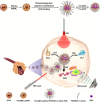All-in-One Nanohybrids Combining Sonodynamic Photodynamic and Photothermal Therapies
- PMID: 39136145
- PMCID: PMC11345719
- DOI: 10.1021/acsami.4c09715
All-in-One Nanohybrids Combining Sonodynamic Photodynamic and Photothermal Therapies
Abstract
A wide variety of methods are being developed to ultimately defeat cancer; while some of these strategies have shown highly positive results, there are serious obstacles to overcome to completely eradicate this disease. So, it is crucial to construct multifunctional nanostructures possessing intelligent capabilities that can be utilized to treat cancer. A possible strategy for producing these multifunctional nanostructures is to combine various cancer treatment techniques. Based on this point of view, we successfully synthesized multifunctional HCuS@Cu2S@Au-P(NIPAM-co-AAm)-PpIX nanohybrids. The peculiarities of these thermosensitive polymer-modified and protoporphyrin IX (PpIX)-loaded hollow nanohybrids are that they combine photodynamic therapy (PDT), sonodynamic therapy (SDT), and photothermal therapy (PTT) with an intelligent design. As an all-in-one nanohybrids, HCuS@Cu2S@Au-P(NIPAM-co-AAm)-PpIX nanohybrids were employed in the SDT-PDT-PTT combination therapy, which proved to have a synergistic therapeutic effect for in vitro tumor treatments against breast tumors.
Keywords: hollow nanohybrids; photodynamic therapy; photothermal therapy; sonodynamic therapy; thermosensitive polymer.
Conflict of interest statement
The authors declare no competing financial interest.
Figures














References
-
- Chang Y.; Cheng Y.; Feng Y.; Jian H.; Wang L.; Ma X.; Li X.; Zhang H. Resonance Energy Transfer-Promoted Photothermal and Photodynamic Performance of Gold-Copper Sulfide Yolk-Shell Nanoparticles for Chemophototherapy of Cancer. Nano Lett. 2018, 18 (2), 886–897. 10.1021/acs.nanolett.7b04162. - DOI - PubMed
MeSH terms
Substances
LinkOut - more resources
Full Text Sources
Research Materials

